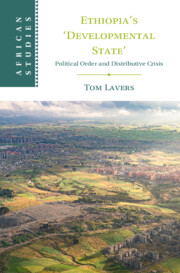Book contents
- Ethiopia’s ‘Developmental State’
- African Studies Series
- Ethiopia’s ‘Developmental State’
- Copyright page
- Dedication
- Contents
- Figures
- Tables
- Acknowledgements
- Abbreviations
- 1 Ethiopia and the Challenge of Late-Late Development
- 2 Structural Transformation, Late-Late Development and Political Order
- 3 Ethiopian State Formation and the Revolutionary Origins of EPRDF Dominance
- 4 Distributive Threats, Elite Cohesion and the Emergence of the ‘Developmental State’
- 5 Land Tenure and Changing Responses to the Agrarian Question
- 6 Industrial Policy and the Challenge of Mass Employment Creation
- 7 Urban Development and the Politics of Expropriation
- 8 Distributive Crises and Access to Social Protection
- 9 Enmeshment and the Limits of State Infrastructural Power
- 10 Distributive Crisis, Elite Fragmentation and the Collapse of the EPRDF
- 11 Late-Late Development and Political Order
- Glossary
- References
- Index
- African Studies Series
- References
References
Published online by Cambridge University Press: 21 September 2023
- Ethiopia’s ‘Developmental State’
- African Studies Series
- Ethiopia’s ‘Developmental State’
- Copyright page
- Dedication
- Contents
- Figures
- Tables
- Acknowledgements
- Abbreviations
- 1 Ethiopia and the Challenge of Late-Late Development
- 2 Structural Transformation, Late-Late Development and Political Order
- 3 Ethiopian State Formation and the Revolutionary Origins of EPRDF Dominance
- 4 Distributive Threats, Elite Cohesion and the Emergence of the ‘Developmental State’
- 5 Land Tenure and Changing Responses to the Agrarian Question
- 6 Industrial Policy and the Challenge of Mass Employment Creation
- 7 Urban Development and the Politics of Expropriation
- 8 Distributive Crises and Access to Social Protection
- 9 Enmeshment and the Limits of State Infrastructural Power
- 10 Distributive Crisis, Elite Fragmentation and the Collapse of the EPRDF
- 11 Late-Late Development and Political Order
- Glossary
- References
- Index
- African Studies Series
- References
Summary
- Type
- Chapter
- Information
- Ethiopia’s ‘Developmental State’Political Order and Distributive Crisis, pp. 313 - 347Publisher: Cambridge University PressPrint publication year: 2023
- Creative Commons
- This content is Open Access and distributed under the terms of the Creative Commons Attribution licence CC-BY-NC-ND 4.0 https://creativecommons.org/cclicenses/



